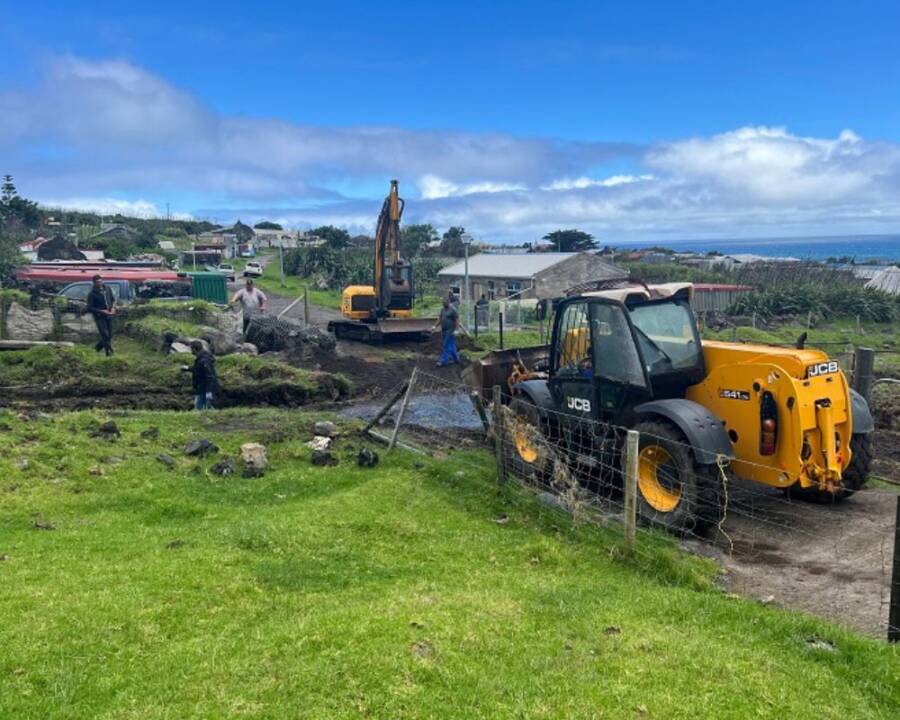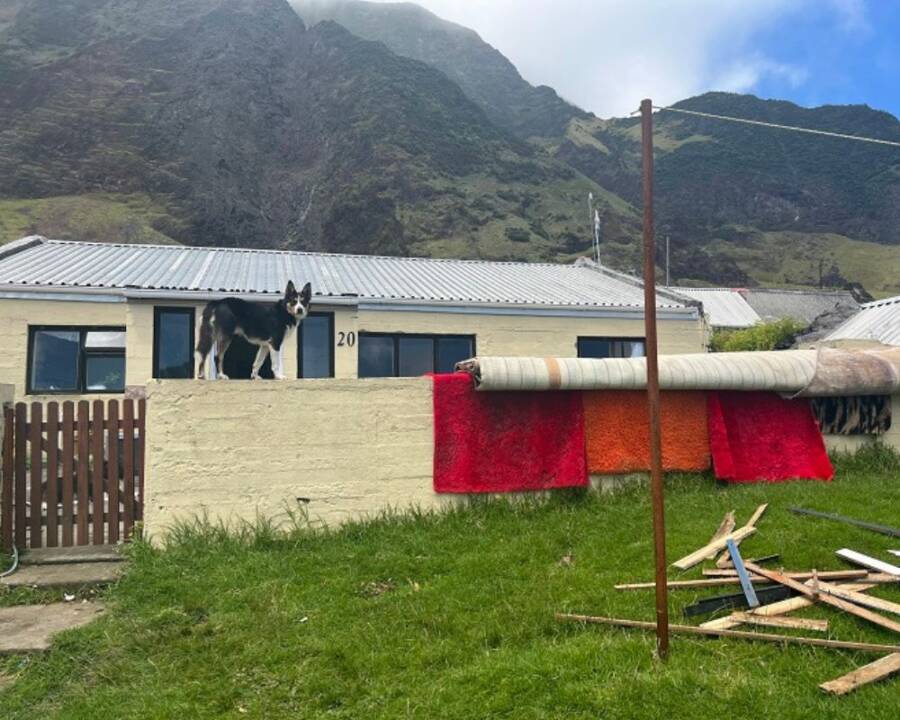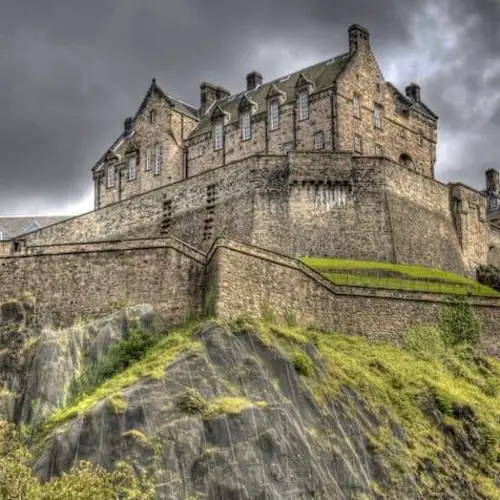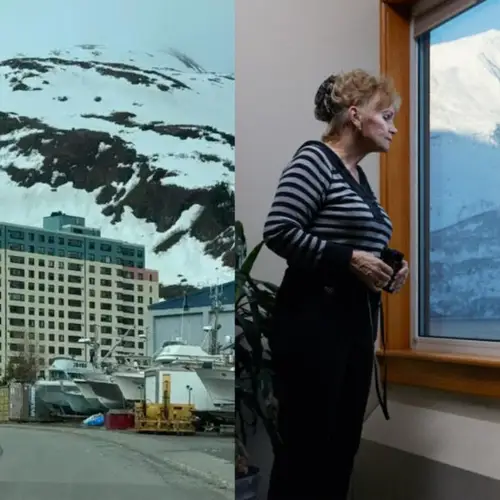Located on the British Overseas Territory of Tristan da Cunha, Edinburgh of the Seven Seas is Earth's most remote settlement, situated more than 1,500 miles from the closest populated area.
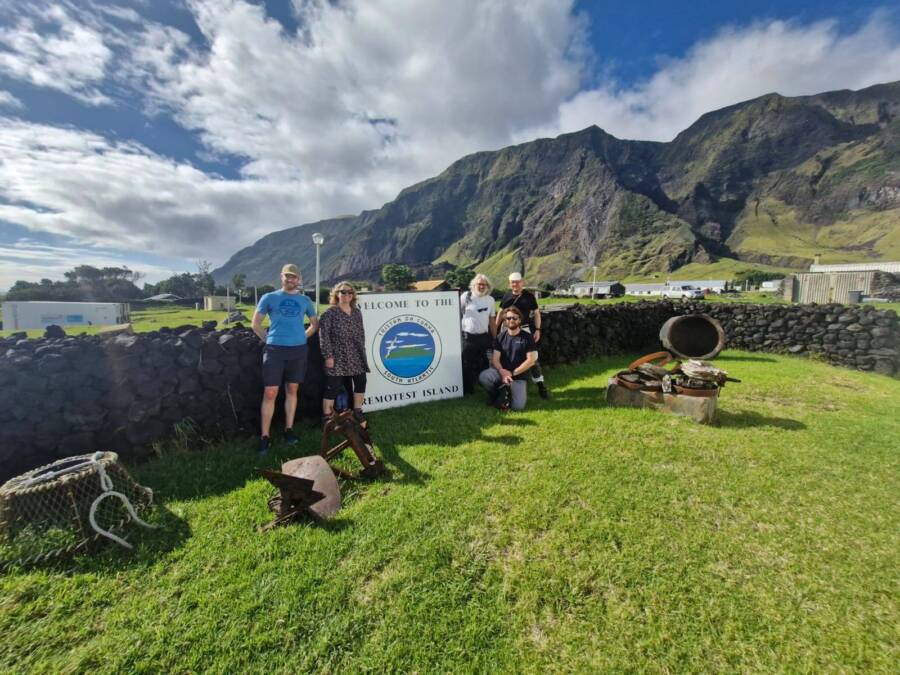
Tristan da Cunha Post & Tourism Direct/FacebookA sign outside of Edinburgh of the Seven Seas reads “Welcome to the Remotest Island.”
Edinburgh of the Seven Seas is the sole settlement on the tiny island of Tristan da Cunha. With a population of just around 250 people, life there is quiet and isolated.
The island is in the middle of the South Atlantic Ocean. In fact, Edinburgh of the Seven Seas is considered the most remote settlement in the world because it’s located about 1,600 miles from mainland South Africa and nearly 1,500 miles from the next populated area, Saint Helena.
Residents of Edinburgh of the Seven Seas rely on fishing and farming for their food, resulting in a local economic structure that is self-sufficient. The land is communally owned, stock numbers are strictly controlled for pasture conservation — and so that no one can accumulate too much wealth — and many adults of the settlement have secure, salaried jobs within the local government.
There is little wonder why people refer to it as a “utopia.” Of course, there’s a catch: No outsiders are allowed to buy land or settle in Edinburgh of the Seven Seas. This is unfortunate news for anyone hoping to escape to a simpler life away from the chaos of the world, but it is also a necessary measure to ensure that this small community can maintain its traditional way of life.
The Discovery And Settlement Of Tristan Da Cunha
According to the official website for the government of Tristan da Cunha, the island was first discovered in 1506 by the Portuguese Admiral Tristão da Cunha when he was en route to the Cape of Good Hope. It began appearing on nautical maps a few years later.
At the time, however, no attempts were made to settle on the island — sensible, perhaps, given its distance from the mainland and the technology of the era.
A century later, in 1643, the Dutch ship Heemstede landed on the island to replenish supplies, prompting two further expeditions of Tristan da Cunha in the 17th century to determine if the area could provide some benefit as a supply station for ships. The idea was ultimately abandoned, but visits to the island did not stop. Soon, other nations took an interest.
In 1810, Jonathon Lambert of Salem, Massachusetts, led a small party of men to set up a trading station on the island, which he dubbed "Reception." Three years later, the HMS Seiramis arrived to find that only one member of the party remained and that the others had all perished in a fishing accident.
Finally, in 1816, the British claimed the island in the name of King George III and established Fort Malcolm, largely out of concern that the French would claim it first. At the time, Napoleon Bonaparte was imprisoned at the similarly isolated island of Saint Helena, and the English worried that they might lose out on a stronghold of potential strategic value.
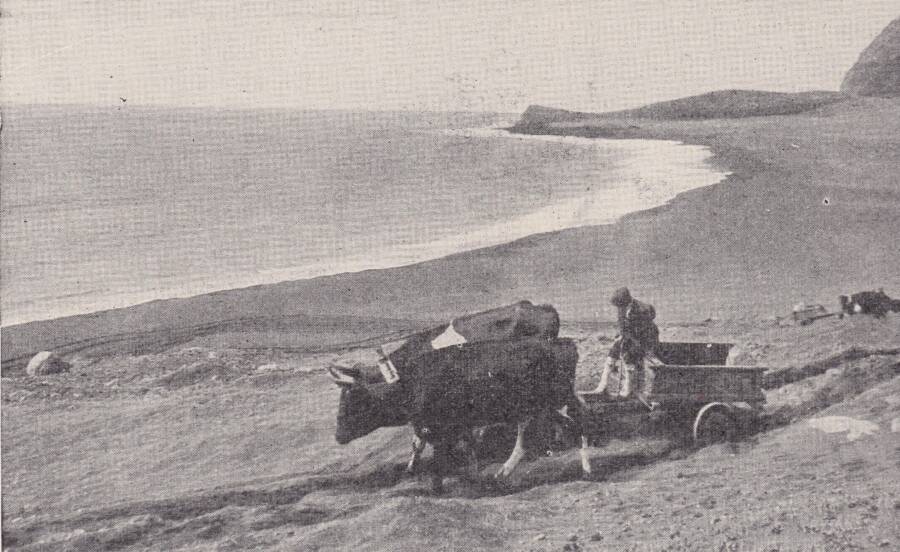
Michelle Bridges/Alamy Stock Photo Residents of Tristan da Cunha riding an ox-drawn cart in the 1930s.
It wasn't long until the British Admiralty dismissed these notions, however, and the garrison of men stationed at Fort Malcolm was called back to England.
That didn't mean the island would remain abandoned, though. Three of the soldiers decided to stay on Tristan da Cunha. They signed a voluntary agreement of communal living that included equal shares of stocks and stores, equally divided profit, and an order that there would be no superiors or subordinates.
The agreement, signed on Nov. 7, 1817, established the core tenets of the community that continue to this very day. In 1867, the settlement took on the name Edinburgh of the Seven Seas after a visit by the Duke of Edinburgh, Queen Victoria's second son. However, residents simply refer to it as "the Settlement."
The population of the island was inconsistent for much of the next century. It was so isolated during the First World War, for instance, that the inhabitants were unaware the conflict had even started until they received word in 1919 that it had ended.
Today, Edinburgh of the Seven Seas' population hovers around 250 people — and the residents intend to keep it that way. After all, the small, isolated community is free from many of the systemic stressors faced by larger societies.
Daily Life In Edinburgh Of The Seven Seas

Colin Waters/Alamy Stock Photo Residents of Edinburgh of the Seven Seas in 1946, waiting for the supply ship HMS Carlisle.
Even today, reaching Edinburgh of the Seven Seas is quite the journey. The settlement is about 1,600 miles from Cape Town, South Africa, and the only way to reach it is by boat, crossing over turbulent waters. While it is not as isolated in the modern age as it was in the past, visitors to the town are carefully vetted, and many who set out to visit turn around before reaching the shore.
Still, it is possible to visit Edinburgh of the Seven Seas. BBC Four's Stewart McPherson documented his trip to the island in 2016, for instance, and interviewed residents about what it's like living there.
"It's a nice life," said Harold Green, who has lived on the island for his entire life. "Everyone on the island, we call them brothers and sisters. We act as a big family, we share and share alike. If they kill a[n] oxen, they always give everybody some piece of beef or mutton or fish — anything... They are there to help you."
According to Green, there is a deeply embedded sense of trust among the community. Residents don't lock doors, the children are safe to roam about, and neighbors are eager to lend a hand if someone needs help.
The town itself is naturally quite small. It has two churches, a school, a village playground, a hospital, a supermarket, a post office, and a tourism center that features things like the Café da Cunha and a souvenir shop. The buildings are single-story, and each family in the town is responsible for several patches of farmland where they grow crops and take care of livestock.
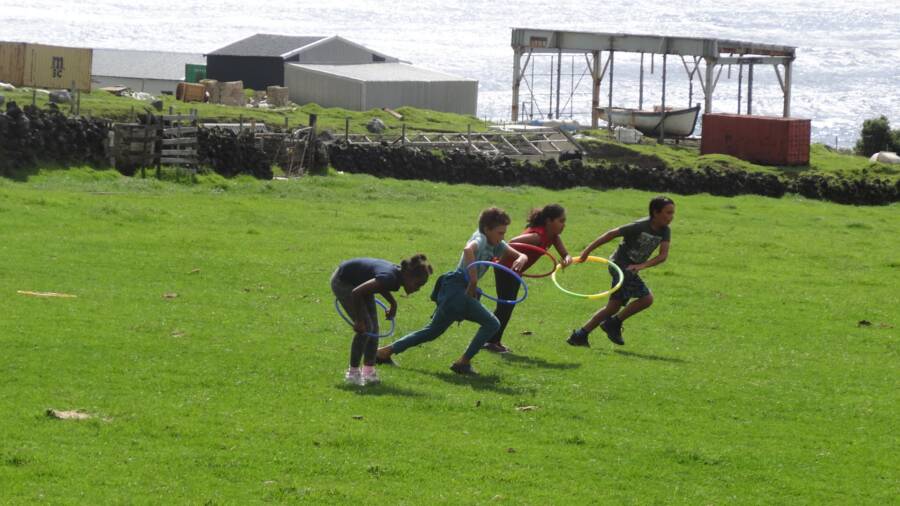
Tristan da Cunha Post & Tourism Direct/FacebookLocal children competing in a game.
Island officials describe the economic structure as "a model of flexible working which is the envy of many people stuck in a career routine." Everyone, including children, helps on the farms, and adults have an additional salaried job either with the local government or the fishing company.
But this isn't the same as working two or more jobs in America, where a "hustle" mentality would cause a person to burn out.
Edinburgh of the Seven Seas largely takes in revenue from the crawfish industry, shearing sheep's wool, and selling postage stamps and coins to collectors. Because it is so small, isolated, and self-sufficient, there seems to be less desire among its residents to hoard mass amounts of wealth.
While much of the island's history is rooted in English culture, there is one unique tradition the residents hold dear: the Okalolies of Old Year's Night.
Edinburgh Of The Seven Seas' Fascinating End-Of-Year Tradition
In May 2024, KCCU reported on the Tristan tradition of the Okalolies of Old Year's Night.
Think of the tradition as something akin to the Krampusnacht of Austria, or the Welsh Mari Lwyd, combined with Halloween. Celebrated on Dec. 31, just hours before the New Year, the tradition involves the young men of the island — around 15 or so, usually — dressing up as the Okalolies and going around causing (light) mischief.
Visually, the Okalolies are vibrant monsters. They sport masks of things like demons, trolls, animals, or notably creepy clowns and adorn themselves in bright-colored clothing. Throughout the day, they travel around the village, playfully scaring older children and adults as a test of bravery.
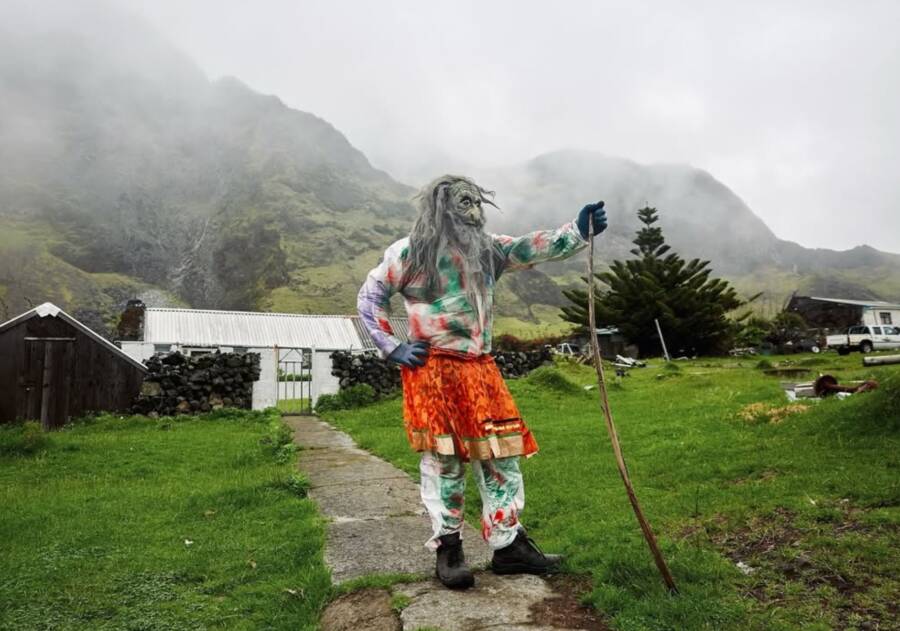
Julia Gunther/InstagramA resident of the island dressed as one of the Okalolies.
Albert Green, a 67-year-old resident, recalled his first time dressing as an Okalolie when he was younger. When he and a friend had finished their costumes, "we had our backs to one another and when we turned 'round, we both jumped with fright."
Although the Okalolies have traditionally always been men, there was at least one instance in which a young woman, Liza, managed to trick the boys into thinking she was one of them back in the 1970s. It was easy enough — the Okalolies don't speak, because that would give away their identities.
As for why the tradition started or where the name Okalolies came from, no one is entirely sure.
One theory is that the word comes from the Afrikaans "Olie Kolonies," meaning "old ugly men," but the jury is still out. Given how similar it is to other European traditions, researcher Peter Millington suggested the Okalolies were likely "an amalgam of the customs of the home countries of the original settlers, including families no longer present on the island."
The Okalolies are in a way symbolic of Edinburgh of the Seven Seas as a whole: something uniquely its own, yet familiar. Edinburgh of the Seven Seas is like a village from a bygone era, when communities were smaller and disconnected — a far cry from the globalized, chaotically instant world most of us live in.
After this look into Edinburgh of the Seven Seas, one of the world's most isolated communities, learn all about the six most remote locations in human civilization. Then, read about Hans Island, the Arctic outpost that also stood at the center of one of the strangest "wars" in human history.


